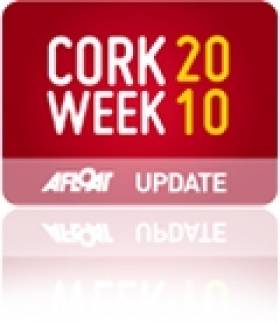Displaying items by tag: sailing
Cork Week and How You Can Win
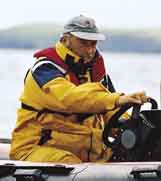 How you can win at Cork Week
How you can win at Cork Week
with more than a little help from local expert Eddie English [pictured left] – Cork Week 2004 (reprinted from Afloat July 2004). For all the up to date information and news on Cork Week click here.
Eddie English stands high on Cobh’s historic waterfront and looks out across Cork Harbour, south towards Roche’s Point Lighthouse and the entrance to the natural sanctuary. Immediately below, a huge Brittany Ferries ship heads slowly out to sea; it’s not even close in size to a previous visitor to the former Queenstown, but then again, the RMS Titanic belonged to a different era.
To his left, the inshore waters north of the Whitegate oil refinery hide the channel to East Ferry where the Marlogue Inn stands over its marina and just opposite, the legendary Murphs on the mainland shore.
On his right, the channel between Spike and Haulbowline Islands and Cobh is the main shipping route for the Port of Cork for ferries, commercial shipping and the Irish Naval Service base.
But it’s the view straight out to sea that confirms one of the magic ingredients that have made Cork Week an international regatta of worldwide repute: vast tracts of open, unobstructed water and all within easy reach of the shoreside facilities of the hosts at the Royal Cork Marina at Crosshaven.
When it comes to local knowledge, few are as expert as English. Not only is he chairman of the event's racing committee, not only does he run a long-established sailing school in the harbour, but when you are offered an insight from someone who takes his dog for a walk on notorious mud banks at low water springs, they tend to be nuggets of the golden variety.
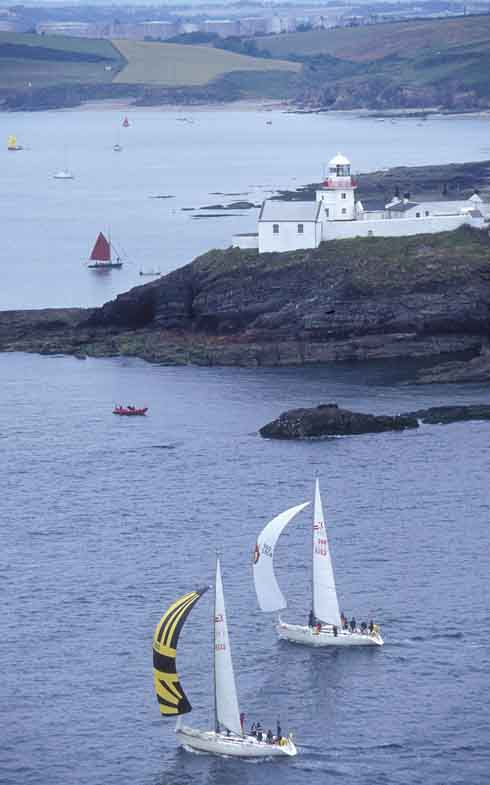
Left: Sigma 33s negotiate Roche’s Point
"The harbour course is the key to Cork Week," says English. "It's the decider where the event is won or lost and has the most variables involved." So this, then, is the Eddie English step-by-step guide to gaining an edge for that course, plus the coastal, wind/leeward and Olympic-type courses at Cork Week 2004.
Harbour Race
Above all, be conservative at the start of the Harbour Race if the tide is with you on the start off Weaver's Point. There can be two knots of tide here typically and an OCS in any fleet represents the end of the story with recovery improbable. Ideally, a short tour of the harbour during the weekend registration stage of Cork Week will pay dividends. If you can, borrow a RIB and take the tour at low-water.
Two marks form part of this course outside the harbour and rounding order will depend on wind-direction on the day. The first is off Ringabella to the south-west shore heading towards Kinsale. If there’s a flood tide, hug the shore. In fact, if the breeze is SW, go right, even in an ebb.
The second is off Trabolgan, east of Roche's Point. Crucially, beware of the strength of tide when traversing the channel across the harbour entrance. Don't just rely on the GPS – plot the tidal vectors to find the true course to steer. Once to the east of Roche's Point, there’s negligible tide and often a tide line can be observed.
This course then takes the fleet into the harbour but beware when entering on the east side of the Harbour mouth – the Cow and Calf rocks are extensions of Roche's Point up to one cable off the shore.
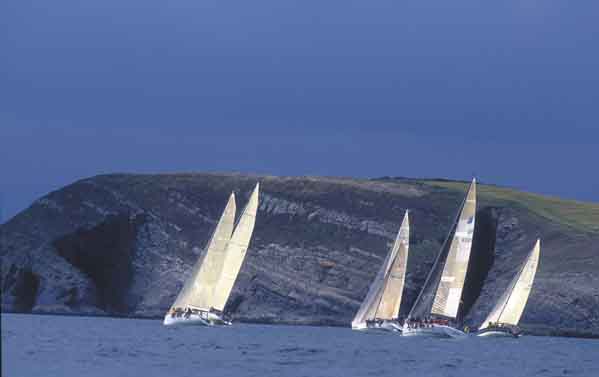
Above: Hugging the shoreline for a tactical advantage
Most races will come into a buoy east of Cobh, making this a long leg in, but offer plenty of hazards on a falling tide. After the Cow and Calf, it’s possible to dodge into White Bay but be wary of rocks and shallows on the south end of the bay close to Roche's Point.
The Dog's Nose promontory is next and it’s possible to cut into the area north of here though close inshore it shallows and the Black Rock is marked by a perch as the main hazard.
Bear in mind the sailing instructions that require clearance of 50 metres off the oil refinery jetty at all times. A listening watch on VHF Ch. 12 is useful for avoiding shipping.
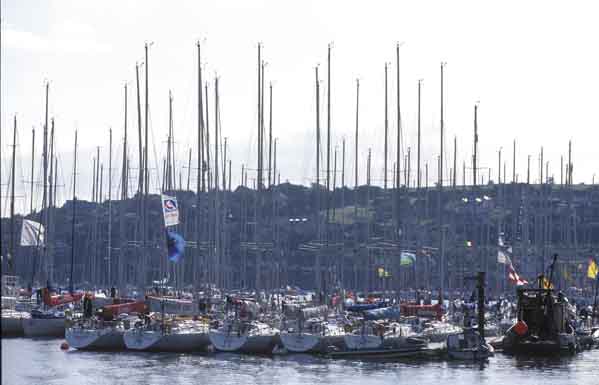
Above: The fleet at anchor – everyone’s gone to the pub...
Once past the refinery jetty, the tide running north-east/south-west for the East Ferry channel can suck you in or push you out.
The alternative to the eastern shore approach is to hug the western shore and involves rock-hopping from Ringabella in past Weaver's Point. An option is to duck into the Owenbue River at Crosshaven – the tide ebbs here up to 30–40 minutes before HW Cobh.
North of here, the Curlane Bank, south of Spike Island, offers an option but beware of shallows. The area south-east of Spike is littered with rocks and, in particular, off the eastern end is a large rock marked by a perch.
The Spit Bank is the biggest in the harbour and is located from the north end of Spike from the lighthouse to the corner off Haulbowline. On very low spring tides, football is played on this bank. The key here is: go as close as you dare. The bank is mostly mud except for ‘The Seven Stones’ aka The Ballast Rocks located approximately two cables east south-east of the No. 20 (Port) Buoy.
Having made the turn for the final approach to the Cobh rounding buoy, one of the showcase marks in the entire event set beneath the picturesque back-drop of the town, this leg from ‘Cuskinny Turn’ offers several options in tide. With the tide is a straight-forward matter of choosing the deepest water so check the charts. Usually, the north shore offers no significant gains. Keep a sharp watch for the passenger ferries running from Cobh to Spike and Haulbowline Islands.
From Cobh, the Harbour Race will have a new finishing line in 2004, moving to the No. 7 (starboard) buoy south of the refinery.
Coastal Course
Going west from the start in a south-westerly or filling sea-breeze, taking the right-handside of the course, pays off, thanks to lifts off the shore. Use the bays to get out of the tide, with the exception of the first bay after Robert's Head/Daunt buoy – it’s called Rocky Bay and it is!
The tide here follows a south-west/north-east direction in line with the heads with a one-knot maximum. Keep the harbour entrance strategy from the previous course notes in mind too.
For 2004, the former south-east mark located approximately three miles east of Roche's Point has been renamed Moonduster as a tribute to the late Denis Doyle and his legendary 51-foot yacht that is synonymous with Cork.
All Courses
The Olympic and windward/leeward are located outside the harbour so allow plenty of time to get afloat – some courses could take you up to an hour to reach as the number of yachts leaving Crosshaven at one time can mean congestion. The furthest course is three miles south-east of Roche's Point which in turn is two miles from Crosshaven. Don't assume the Race Officers will wait – best advice is to follow the professionals' example and leave early to be at sea on time with an opportunity to practice a few crew drills.
These courses usually have no significant tidal factors as most are located outside the harbour and beyond the main entrance tide line. More importantly, if a sea breeze builds, this will be of more use to you.
If a sea-breeze applies, it generally tends to build from around 11am, peaks at 3pm and is gone by 6pm. It will usually begin in the south/south-east provided the gradient doesn't block it. It tends to veer throughout the day until it comes from the SSW to SW – always moving right as the day progresses. Be vigilant to spot it building as it applies to all courses.
Cork Week, How Rocketships work
Jargon – How the Cork Week Rocketships Work
Sailing fast is all about converting the wind’s energy into boat speed and these big ocean racers generate more horsepower and speed for their size than any single-hull craft that has ever sailed the seven seas.
When the wind blows over 20 knots they leave pursuing powerboats wallowing in their wake. Photographers have to resort to helicopters.
The secret to the success of these high-tech speedsters is their weight-saving, super-strong, carbon fibre construction and their radical underwater design.
Gone are the keel and rudder combinations of conventional sailboats where the shape and weight of the keel counteracts the heeling effect of the wind and helps prevent the boat making leeway (slipping sideways).
In place of the keel is a slender strut with a nine-ton ballast bulb at its tip. Swung out (canted) sideways under the boat by a hydraulic ram, the bulb provides extra stability, standing the boat up straighter and making the sails more efficient.
The twin rudders, one ahead of the strut and one behind it, perform a double duty. They provide the foil shape and area to minimise leeway while also improving maneuverability.
Tacking calls for no more than the touch of a button to swing the keel into a new direction.
Disney and Plattner, the CEO of Germany’s SAP software empire, were fellow competitors in a previous class of lightweight 75-foot ocean racers, worked together to create the new class.
"To have a bunch of boats where we can go out and actually have boat races instead of designer races seems to me to be really good idea,‰ Disney said. „That's what I hope for with this project – that it will attract people who want to go racing on the same terms. Not that we all don't like to go a little bit faster than the next guy, but it's a lot more fun when it’s a boat race."
Cork Week Uncovered: Who Will Be There
Cork Week Uncovered: Who Will Be There
From Afloat, July 2006
Cork Week's not all about rubbing shoulders with serious money but, having that said, there will be more millionaires on the banks of the Currabinny river between July 10 and 16 than sails in the harbour. Crosshaven will teem with sailors and supporters for a festival of sailing that’s more like Galway Races on water than a regular sailing regatta.
And that's the reason it’s become so popular with foreigners, attracting 80 per cent of its competitors from overseas.
Pyewacket and Morning Glory may be the big glamour boats but the entry list has 499 other boats as well, the bulk of which are from the UK visitors. Up to 7,000 competitors will take to the water each morning, bringing an estimated 10 million euro into the local economy. That may be small beer to the likes of Roy Disney but in sporting terms it's like having the commercial return of an international rugby fixture in an otherwise sleepy fishing village.
Seven bars, three restaurants, 50 bands, 400 performers and 180 hours of entertainment are ready to serve competitors from as far away as the US, Hong Kong, Australia, France, Germany and Belgium along with a huge representation from England, Scotland and Wales.
On the water the fleets are split over eight different courses according to size of boat. Sailors are categorised too and part of the charm of the race week is that the majority of racing classes prohibit sailing professionals as crew.
Cork Week and the Roy Disney Connection
Cork Week and Roy Disney
By David O'Brien
Reproduced from Afloat Magazine, July 2006.
If sailing faster than the wind sounds like something out a Disney fantasy, then that’s because it was. And now, as Roy Disney - the 73-year-old nephew of the legendary Walt - prepares to hit the water in Cork today, (July 10) that fantasy has become reality for the first time in Europe.
Disney has temporarily left boardroom battles behind him to pitch his stunning yacht against the competition around Cork harbour. His 86-foot, space-age boat, Pyewacket, was fast tracked across the Atlantic on top of a cargo ship directly from Bermuda just to be here in time for the first race of Cork Week, an Irish regatta with a global reputation for fun and great racing, and one which Disney claims he wouldn’t miss for the world.
Depending on how you look at it, the international regatta circuit that has taken him to St Maarten, Tortola, Antiqua and Bermuda this year is either a logistical nightmare or a gorgeous extravagance.
Whichever it is - and Disney reckons it’s probably a bit of both - it's an infatuation that keeps him burning with enthusiasm when sailing is at the top of the agenda. For 50 years he has followed a fantasy to see his boats go faster than all the others - and now he’s living that dream.
This year he has come in for international acclaim, not for his company's movie work, but in yachting circles, for bringing racing to a new level by creating the Maxi big Z86, a yacht that’s capable of sailing faster than the speed of the wind.
Already nicknamed 'the rocketship' by jealous competitors, Pyewacket is one of two such designs built to demolish the world's sailing speed records for monohull boats.
And if they’re untouchable when it comes to straight line racing, the new designs are proving equally superior in around-the-buoys events too. At Antigua Race Week this spring, they left their competition behind in showers of spray and they threaten to repeat that feat at Cork today.
The secret to the success of these high-tech speedsters is a weight-saving, super-strong, carbon fibre construction and radical underwater keel designs.
“Sailing in just 3.5 knots of true wind, we were slipping effortlessly through the water at almost three times that speed during the race to Bermuda. There are not many times when we can't sail faster than the wind,” Disney enthuses. “If we get 15 knots winds, we can sail at 20 knots easily thanks to this design.”
But all these things come at a price and no one is forthcoming - not event the two billionaires owners - on the total development costs thus far.
Ted Heath once said that sailing was like standing in the shower tearing up £5 notes. It's an oft-used quotation but it still draws a giggle from Disney who adds "yeah...and most of the time it’s in the dark too!"
According to insiders, sailing campaigns at this cutting-edge level cost up to $5m a year - and this excludes the capital cost of the boat.
"It's like Rockefeller said: "If you have to ask how much it costs, you can't afford it. And I can afford it," says Disney.
He readily admits that some people ask him if he's mad, to which he replies "We're all crazy, so why not have some fun? When it stops being fun, then that will be my last race."
Joking aside, Disney reckons that he’s now sailing at a level where he can't afford to do it badly.
"I need skilled people to crew this yacht, he explains. “When you sail at 27 knots, the loads involved are huge. I need to sign on the bottom line to have it sailed professionally. Otherwise people could get hurt or lost overboard."
Today's Cork Week race follows Disney's defeat by Hasso Plattner's Morning Glory, Pyewacket's sistership, in a race from Newport, Rhode Island to Bermuda in the last week of June. Plattner, who took a 30-mile lead on Disney in a race the Hollywood giant previously called his own, smashed the elapsed time record previously held by Disney since 2001.
Cork Week therefore represents the first opportunity to avenge this defeat. Royal Cork, not surprisingly, is trying its best to facilitate a pitched battle between the two space-age craft, designing courses that are sure to set the two pitching against one another until the finishing line.
"They could have chosen Cowes or Sardinia to unveil this next generation of racing yacht but they didn't, says Donal McClement of the host yacht club, the Royal Cork. “They chose Cork and that's a big honour for us. McClement has sailed with Disney in previous Cork weeks and will sail again as a local tactician this time.
The fact the world’s big guns are coming to Cork is, of course, a compliment to the organisation for the Crosshaven event, but in Disney’s case it also has something to do with the fact that he’s a member at Royal Cork, and a patron of its junior sailors. He’s had a second home in Ireland - in Kilbrittain in West Cork - for the past 15 years, where he spends up to three months of the year.
Neither Roy's father nor his uncle - the company’s founder, Walt - were sailors, yet they always encouraged his sporting passion for diving and swimming as a teenager.
It's sounds twee to describe Roy’s sailing career as a 'race into paradise' but it’s still an accurate description of the movie-maker's 50-year journey from weekend family sailor of the Fifties to globe-trotting regatta racer of the new millennium.
In the immediate aftermath of World War II, aged just 16, he flew a prototype aircraft - with the full support of his family. It was the unrestrained joy of playing tag in the clouds with like-minded Californian surfer kids that gave him a life-long love of freedom, and speed.
It's more than likely, he concludes, that this later translated into a love of the sea, a passion he was able to share with wife Patty and four young children on weekend trips.
That buzz still drives him on but as his business pressures have increased over the years, the Disney director, listed by Forbes as the 552nd richest man in the world, finds it increasingly difficult to make a complete break from the office.
The introduction of the on-board satellite phone has, ironically, not helped matters, leading instead to a further diminution of his precious freedom.
On more than one occasion on Pacific yacht races he has been interrupted - a thousand miles from land - by the Disney corporation who want him back for a meeting
"Sorry you can’t have me, I'm half way to Honolou," he recalls telling executives who were insisting on his return recently.
As a nephew of Walt, he worked at Mouse Factory for 24 years as a film editor, writer and producer. He left in 1977 but returned seven years later as vice chairman. Credited with rekindling Disney’s love of the animated film - scoring huge success with The Lion King and Little Mermaid - he became chairman of the Feature Animation Division.
However, it hasn’t been his yachting exploits that have raised his public profile so dramatically in the past year. Instead, Disney has become better known - at least among land-lubbers - for his bitter and very public battle with Disney Chairman and CEO Michael Eisner.
On 30 November last year, he resigned from the company, denouncing Eisner for (among other things) the loss of company morale through micro-management, building newer theme parks "on the cheap", changing the company's public image as "always looking for the 'quick buck'", the defection of creative talent to other companies, failure to establish lasting relationships with creative partners and not establishing a management succession plan. Eisner was then stripped of his role as chairman by the Disney board in March - being replaced by Northern Ireland peacemaker George Mitchell - but survived as CEO. It was a half victory for Roy Disney, then, and he has vowed to continue the fight. “ I’m competitive of the water too, you know” he says.
Sailing, he says, releases him from this tension and provides the breaks he needs from the bruising and protracted battle for the right to control Disney’s future.
"Pretty soon you'll be able to read about my success over Eisner,‰ he says, „but in the meantime you might like to have a look at www.savedisney.com.‰ The comment may look innocent enough on paper, but the way in which it is delivered provides an insight into his gritty determination both on and off the water.
"The guy who is running the company for us for the past 20 years is trying to get me out and I'm not taking that lying down," he vows.
Next week the corporate battle stops for Disney. Satellite phone or no, he’ll need to have all hands on deck to fight off the challenge from Morning Glory. If you want to see the technological marvels at first hand, before the circus moves on to Sardinia, head down to Roche's Point and look out over Cork harbour to see an American billionaire sailing faster than the wind. For once in his life, Disney won’t be steering a Mickey Mouse operation.
Warrenpoint Harbour Authority
Warrenpoint Harbour Authority
Warrenpoint Harbour Authority seeks to operate profitably within fair and competitive tariff arrangements so that the Port is economically sustainable. Its aim is to contribute as much as possible to the generation of economic wealth within the Port and its regional hinterland.

Consequently, profit optimisation, to achieve its primary mission rather than profit maximisation, will be pursued.
History
The original Port of Warrenpoint, consisting of a wet dock and piers, was constructed in the late 1770s by Roger Hall, Robert Ross and Isaac Corry with the assistance of £500 of public funds. In 1919 the heirs of Roger Hall sold the Port to John Kelly and Sons for the sum of £16,000. John Kelly continued to operate the Port until 1971 when it was sold to Warrenpoint Harbour Authority for £369,000.
The Port was substantially enlarged with an initial total investment of approximately £6.7million to create the modern Port of Warrenpoint. Until 1971 the Port of Warrenpoint acted as a lightering port for the Port of Newry and jointly these ports handled approximately half a million tonnes of cargo annually. Subsequently the modern Port of Warrenpoint has handled 5 times as much cargo on an annual basis.
Warrenpoint Harbour Authority, The Docks, Warrenpoint, Co. Down, N. Ireland BT34 3JR. Administration/General Enquiries – Tel: 028 417 73381 • Fax: 028 417 52875. Operations – Tel: 028 417 52878 • Fax: 028 417 73962• Email: [email protected]
Howth Harbour
Howth Harbour
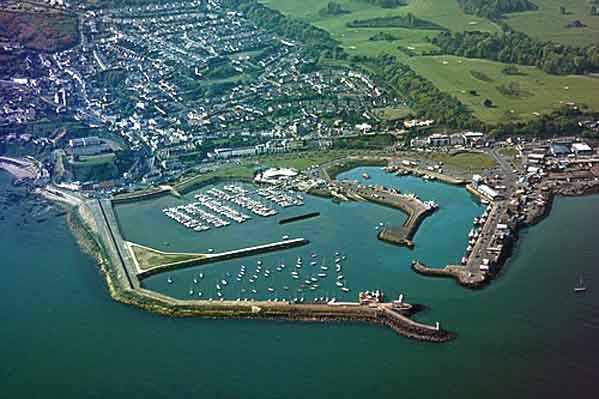
A picturesque fishing village nestled on the rugged peninsula that forms the north side of Dublin Bay, Howth is one of Ireland’s many hidden treasures. That is not to say that the village doesn’t receive its fair share of visitors. Far from it. Howth is a favourite holiday destination and benefits especially from its popularity amongst yachtsmen and pleasure boaters. Indeed Howth Yacht Club dates back to 1895 and with around 2,000 members it is by far the largest in the country and enjoys a busy programme of racing, regattas and voyaging. The marina and club complex combine state of the art with old and traditional with standards of services superb across the board. As you would expect from such a large club, berths are plentiful and marine services top notch.
Away from the harbour itself there is much to recommend Howth. Historians will love the ruined abbey, nearby Baily Lighthouse and 15th century castle. You can take a bracing stroll along the piers, sight-see aboard an open top tram, watch seals and dolphins in the waters along the shore and take in breathtaking views from cliff top walks. Of course, Howth’s working fishing port means that fish and seafood lovers are absolutely spoilt when it comes to dining out and the pub scene is second only to Dublin itself, if a little more relaxing.
Howth is a lovely place from which to discover Ireland. You can blow away the cobwebs and kick back and explore the magnificent coastline at your leisure knowing you will be returning after each trip to one of the friendliest places on earth. And that’s the truth.
Marine Services in Howth – click here
Pilot Notes for Howth – click here
Marinas in Howth – click here
Accommodation in Howth – click here
Emergency
Fire/Ambulance/Police: 999/112
Customs: 874 6571
Harbour Master: 83 222 52
Lifeboat: 8323 524
Beaumont Hospital: 83 777 55
Tourist Information – Fingal Tourist Information Office +353 1839 6955
Air Travel
Aer Lingus: 705 3333
British Midland: 283 8833
RyanAir Flight Information: 1550 200200
CityJet: 844 5566
Car Ferries
Stena Line: 204 7777
Irish Ferries: 66 10 511
Rail Transport – Iarnrod Eireann (Irish Rail): 83 66 222
Howth Harbour Harbour Master's Office – Captain Raja Maitra, tel +353 (0) 1 83 222 52 or mobile 086 3814926. fax +353 (0) 1 832 6948 (Office situated Northern End of Auction Hall)
Port of Greenore
Port of Greenore
 Greenore is a small town and deep water port on Carlingford Lough in Co. Louth, Ireland. The population of Greenore and the surrounding rural area (electoral area) was 898 in the 2002 Irish census.
Greenore is a small town and deep water port on Carlingford Lough in Co. Louth, Ireland. The population of Greenore and the surrounding rural area (electoral area) was 898 in the 2002 Irish census.
Greenore has the only privately owned port in Ireland. It has three berths and can handle vessels of up to 39,999 gross tons. In 1964 the port was used to fit out the ships used for the pirate radio stations Radio Caroline and Radio Atlanta (later Radio Caroline South). In the 1970s there was regular freight shipping from the port to Bristol. In 2005 Greenore was Irelands's 10th port with 649,000 tonnes of goods handled.
Port of Greenore – Port Authority: Greenore Ferry Services Ltd., Greenore Port, Greenore, Co Louth, Ireland. Tel: 353 42 937 3170. Fax: 353 42 937 3567. Email: [email protected]
Waterford Motorboat and Yacht Club
Waterford Motorboat and Yacht Club
 WMYC was formed in 1996 and is based at Waterford City Marina, in the south east of Ireland. Its principal activities include cruising in company: River Nore, Barrow and Suir, Waterford estuary, and the South and East Coasts of Ireland. Autumn League sailing races are held over five weekends during September/October each year. Other on-the-water activities include predicted log, duck races and boat handling competitions. There are also various social events held on dry land throughout the year.
WMYC was formed in 1996 and is based at Waterford City Marina, in the south east of Ireland. Its principal activities include cruising in company: River Nore, Barrow and Suir, Waterford estuary, and the South and East Coasts of Ireland. Autumn League sailing races are held over five weekends during September/October each year. Other on-the-water activities include predicted log, duck races and boat handling competitions. There are also various social events held on dry land throughout the year.
Waterford Motorboat and Yacht Club, Waterford Cit. Contact: Ena Phelan, Knockroe, Passage East, Co. Waterford. Tel and Fax: 051 382 767, email: [email protected]
Have we got your club details? Click here to get involved
Waterford Harbour (Dunmore East) Sailing Club
Waterford Harbour (Dunmore East) Sailing Club
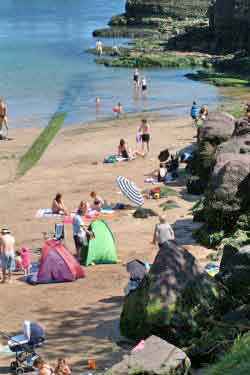 Founded in 1934 this is a family club with around 200 members. The clubhouse was extensively renovated in 2004. Visitors are most welcome and a limited number of visitor berths are available. Showers and toilets are also available to visitors in the summer. The clubhouse, with bar and snack meals, is open daily in the summer and at weekends during the winter. ISA Junior training courses and powerboat courses take place from late June until mid-August. Yachtmaster Coastal and Offshore shorebased courses are available during the winter.
Founded in 1934 this is a family club with around 200 members. The clubhouse was extensively renovated in 2004. Visitors are most welcome and a limited number of visitor berths are available. Showers and toilets are also available to visitors in the summer. The clubhouse, with bar and snack meals, is open daily in the summer and at weekends during the winter. ISA Junior training courses and powerboat courses take place from late June until mid-August. Yachtmaster Coastal and Offshore shorebased courses are available during the winter.
Left: The beach at Dunmore East
COURSES OFFERED – Dinghy: Up to Improving Skills, Advanced Boat Handling, Racing 1, Kites & Wires 1, Adventure 1. Power Boat: 1, 2 and Safety Boat. Cruising Shorebased: Yachtmaster Coastal and Offshore
Waterford Harbour (Dunmore East) Sailing Club, c/o Derry O'Sullivan, The Harbour, Dunmore East, Co Waterford. Tel: 051 383389 and 383230, email: [email protected]
Have we got your club details? Click here to get involved
Clifden Boat Club
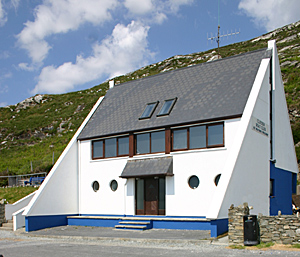
Clifden Boat Club
The Clifden Boat Club is a small sailing Club situated on the west coast of Ireland, just two miles outside the picturesque town of Clifden, Connemara. The committee and members of the club have been working hard to provide fantastic yacht racing and also some great sail training.
The team at Clifden Boat Club, having hosted the West Coast Championships for 2007 and 2008, are looking forward to another exciting and rewarding sailing season in 2009.
The Club is situated at the eastern end of the very sheltered Clifden bay providing great anchorage and easy access to a slip. Clifden harbour is 1km farther east providing a very safe and sheltered tidal harbour with a draft of about 3m at mean high water. The clubhouse itself is close to the Clifden Bay anchorage and has shower/changing rooms a bar and restaurant. Services Available include Visitors Moorings and safe anchorage.
The following is always
available:
Fresh water 25m from slip
Fuel and Lube oil
available in drums from Clifden town and tanker deliveries to Clifden
quay.
All stores available in Clifden town (2km from clubhouse, 1km from
Clifden quay)
Some spares and mechanical repair available
There is an internet Cafe in Clifden. The Boat Club is available for meetings and conferences by arangement. The First port of call for visitors should be the Clifden Boat Club where facilities are available and where information can be obtained.
Committee Details 2009/2010
Commodore – Bobbi O'Regan 0879870371 [email protected]
Secretary – Damian Ward 0872418569 [email protected]
Treasurer – Bobbi O'Regan 0879870371 [email protected]
Assist. Treasurer - Jackie Ward 09521898
Membership Sec – Donal O'Scannaill 0861665278
Liaison Officer/PRO – Damian Ward
Development Officer – Jackie Ward
Safety Officer – Werner Cook 0876427167
Race Officer/Sailing Sec – Paul Ryan 0862931819


























